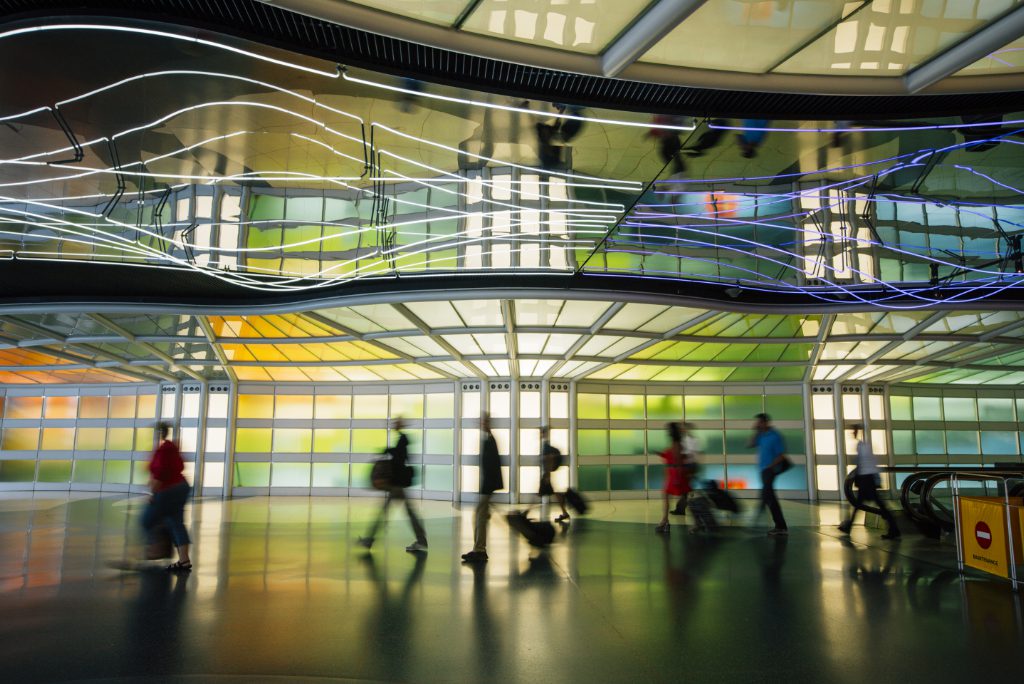Skift Take
Skyfii's acquisition of the startup CrowdVision highlights how computer vision is becoming a key technology for the travel sector. The tech lets airports and other companies generate data and insights to ensure safe and efficient crowd control and optimal retail sales.
Skyfii, a Sydney-based tech company, completed this week its acquisition of CrowdVision, a Los Angeles-based startup that uses artificial intelligence, computer vision, and Lidar (or safe, invisible laser beams) to study passenger flows at airports. The deal will help Skyfii to sell its location-based analytics and marketing tools to airports and other venues worldwide.
“Tracking a passenger’s journey from curb to gate-side is a holy grail for airport operators, but no tech platform can do this well today,” said Skyfii CEO Wayne Arthur. “This acquisition gets us much closer than we think anyone else can for delivering a full picture.”
CrowdVision’s tech is used by 9 out of the 15 largest airports in the U.S., including O’Hare. But the pandemic hurt the startup, which generated only $3.1 million in revenue in 2020.
The deal is small. Skyfii, a public company, acquired CrowdVision with $1 million ($1.2 million Australian) in cash and about $6 million in shares. The transaction gave CrowdVision, which was one of Skift’s Top Travel Startups to Watch 2019, an enterprise value of at least $7 million. Skyfii aims to keep CrowdVision’s 35 customers, most of which are airports, along with the startup’s senior management and other staff.
Computer Vision Has Potential in Travel
The deal highlights the larger possibilities of computer vision technology in similar venues, such as railway hubs and convention hotels. Computer vision enables video cameras to convert visuals into a 3-D digital model, allowing software to figure out an object’s size and shape and detect patterns.
Computer vision can be combined with data from sensors and other signals such as Lidar to measure how people use spaces, count a crowd’s size, or ensure social distancing during a pandemic.
Airports can use this data to improve retail sales at terminal shops, for example, and reduce overcrowding at security checkpoints. They can deploy staff or activate digital signs automatically in response to detected changes in passenger activity.
Multi-sensor location data can be captured and analyzed by travel companies in several ways. Computer vision can study pedestrian, vehicular, or aircraft traffic flows and examine how to make changes to improve efficiency.
Tech companies can combine the data sensors collect from Wi-Fi hotspots, beacons, cameras, and other signals to help airports monitor their spaces. The data lets operators track parking capacity for passenger cars, efficiency and wait times at check-in counters and security checkpoints, and crowd management and staff optimization at gates and lounges.
Skyfii plans to integrate Crowdvision’s product to give operators of airports and other venues a single dashboard for viewing patterns. The startup has specialized in monitoring mission-critical crowd management areas such as security checkpoints with technology like Lidar and computer vision.
“It’s not practical to deploy Lidar to track passengers all the way through an airport,” Arthur said. “So we use a mix of data sources to piece together a picture.”
The smartphones and other mobile devices in passenger pockets emit signals that airport tech vendors can use to detect passenger movements without knowing personal information about the traveler. If passengers log in to airport Wi-Fi run by Skyfii, the company can usually identify the passenger to enhance the precision of tracking through crowds.
A stock placement this spring gives Skyfii a cash balance of approximately $5.7 million ($7.9 million Australian) to enable it to speed up its sales and technology growth or make an additional acquisition.
Skift AI Travel Newsletter
AI coverage across travel sectors that’s focused on separating trendy moves from good ideas – in your inbox every Friday.
Have a confidential tip for Skift? Get in touch
Tags: airport technology, airports, artificial intelligence
Photo credit: Terminal 1 of O'Hare international features artwork by Michael Hayden. O'Hare has been a customer of tech from CrowdVision. Clayton Hauck / O'Hare International Airport
